The most amazing Naan bread recipe – brushed generously with salted garlic butter, soft, chewy, and packed with flavor. With just a few basic ingredients and simple steps, you’ll be able to whip up soft, fluffy naan bread that pairs perfectly with your favorite curries or as a tasty snack on its own.
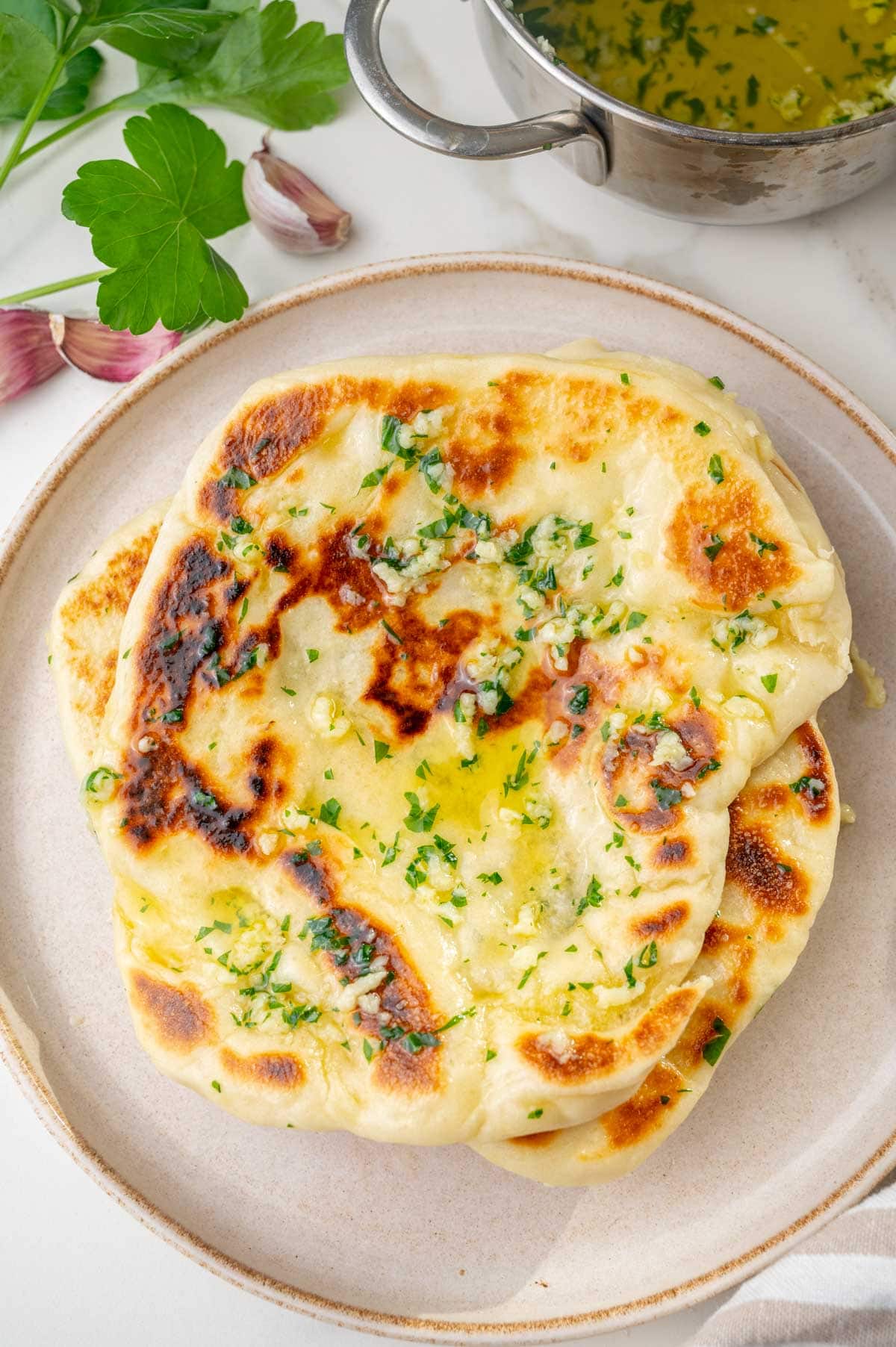
What is Naan?
Naan bread (pronounced “nah-ahn“) is an Indian yeast-leaven flatbread traditionally baked in a very hot Tandoor oven. Tandoor is a cylindrical clay oven that is heated to very high temperatures. Naan bread is placed in the oven on its inner walls, it adheres to the walls and bakes very quickly until puffed and charred. After baking it’s brushed with melted butter and sprinkled with seeds.
Ingredients
Below you will find information about the ingredients and how to prepare the recipe. For the measurements and detailed instructions scroll down to the printable recipe card.
Here’s what you need to make Naan bread:
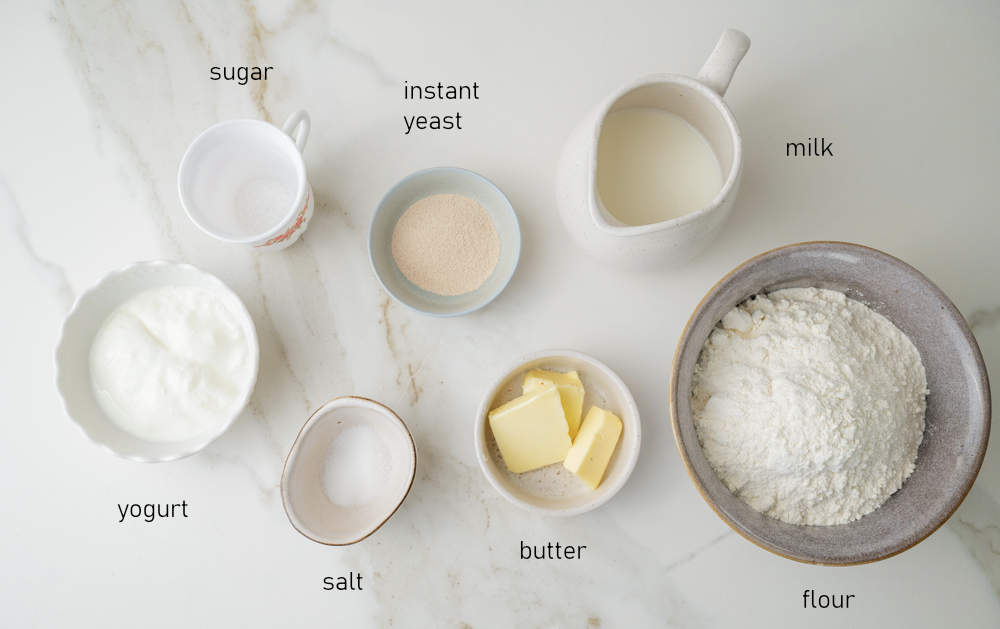
- All-purpose flour – you can use bread flour if you have it on hand but all-purpose flour really makes an excellent Naan.
- Instant Yeast – this is what makes Naan fluffy and light. It also adds flavor. You could make Naan with just baking powder and baking soda but it’s nothing compared to when using yeast!
- Yogurt – an important ingredient for Naan bread – it gives it a soft and chewy texture. You want to use just the right amount – not too little and not too much. If you use too much, it can make your Naan too heavy and it won’t puff up properly. Use regular full-fat plain yogurt, not Greek yogurt (Greek yogurt can also make it too rich and heavy).
- Milk – for better flavor. You can use water instead but it’s better with milk.
- Melted butter – makes the Naan soft and adds flavor.
- Sugar – just a small amount that provides a better flavor.
- Salt.
Some recipes call for using yeast, baking powder, and baking soda all together. I’ve tried that, and yes, this kind of Naan is a little bit softer and fluffier. However, I prefer using just yeast because then you have soft and fluffy parts of the bread, and in the middle, the thinner parts are slightly crunchy – which we prefer in our Naan bread. When using all three – yeast, baking powder, and soda – the Naan is just soft and fluffy.
An integral part of a Naan bread recipe (at least for us) – garlic butter! Here’s what you need:
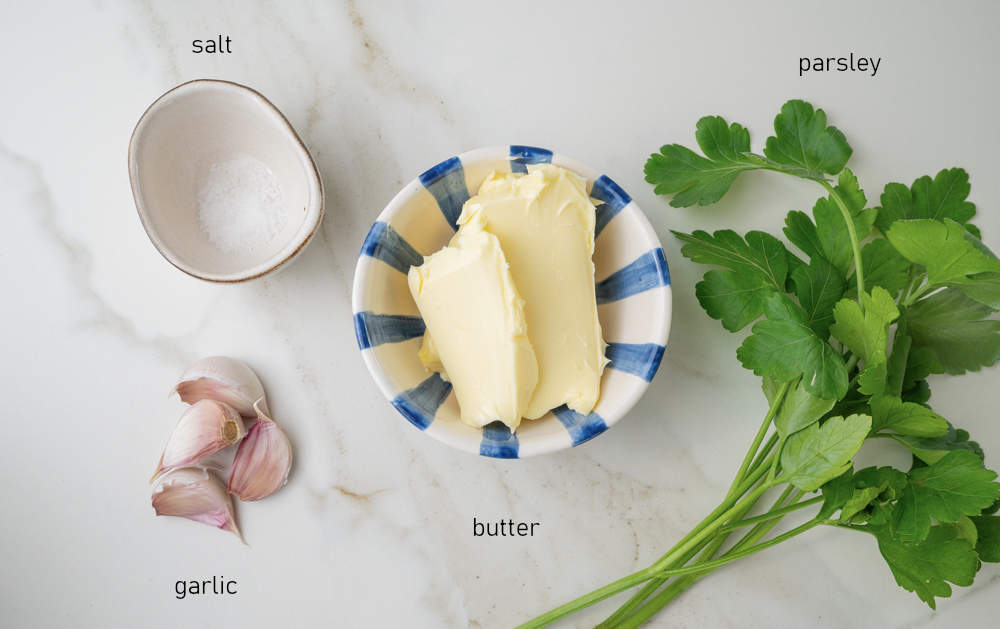
- Butter
- Salt – make sure your Naan is properly salted – it’s crucial for the perfect Naan experience.
- Garlic – Fresh garlic is a must, no garlic powder! If you’re not a fan of pungent fresh garlic flavor – you can cook it briefly in butter to retain the garlicky flavor but lose some of the harshness.
- Parsley – for flavor and a pop of color. Optional, but recommended. Cilantro would also work well, but I prefer parsley.
How to make garlic Naan – step-by-step
Make the dough:
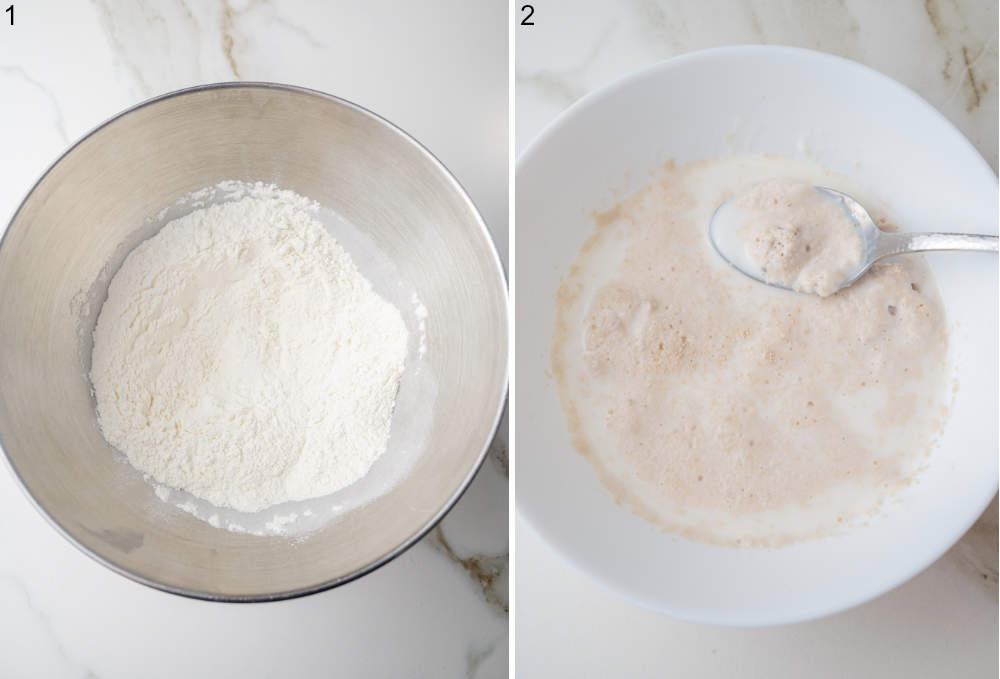
Proof yeast (not entirely necessary if using instant yeast but it helps to be sure that yeast is working and the dough is rising faster): Heat milk to 100-105°F (38-40°C) – it should be pleasantly warm to the touch, it can’t be too hot. Add sugar, and yeast, and set aside for 5-10 minutes. After this time the mixture should be foamy – a sign that yeast is working. If it’s not – you need to start over.
(1/2 cup (120g) milk, 1 teaspoon sugar, 1/2 tablespoon instant yeast, 6g)
In a medium/large mixing bowl, stir together flour and salt.
(2 cups (250g) flour, spooned and leveled, not scooped, 3/4 teaspoon fine sea salt)
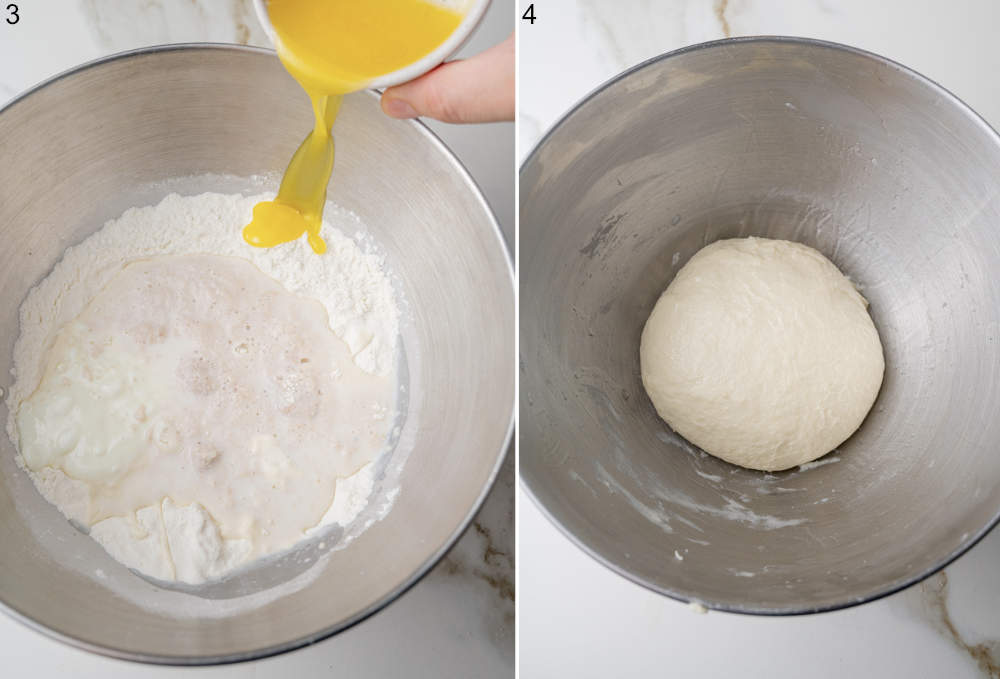
Add the yeast-milk mixture, melted and cooled butter, and yogurt.
(2 tablespoons (30g) butter, 1/3 cup (80g) plain full-fat yogurt)
Stir with a wooden spoon until roughly combined.
Knead by hand or with a mixer fitted with a dough hook attachment. The dough will be very sticky so it will be difficult to knead by hand. Add more flour if you must, but try to avoid it. If using a mixer, knead the dough for about 5 minutes or until it pulls away from the edges of the bowl.
Coat your hands in a small amount of vegetable oil and take the dough out of the bowl on a counter or a rolling mat.
Grease the bowl with a small amount of oil. Knead the dough briefly until it forms a smooth ball that is not sticky anymore.
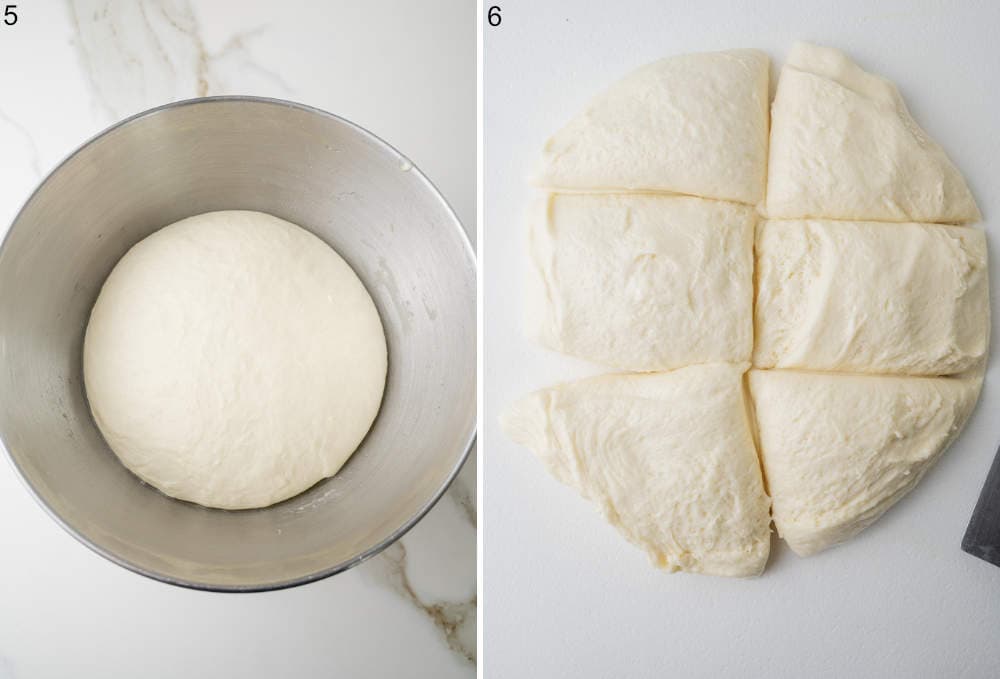
First rise: Put the dough back in the bowl. Cover it with plastic wrap and set aside until doubled in volume, for about 1 hour (I’m putting it in a turned-off oven with a light on).
Shape the flatbreads: Place the dough on a counter/silicone rolling mat and divide it into 6 parts.
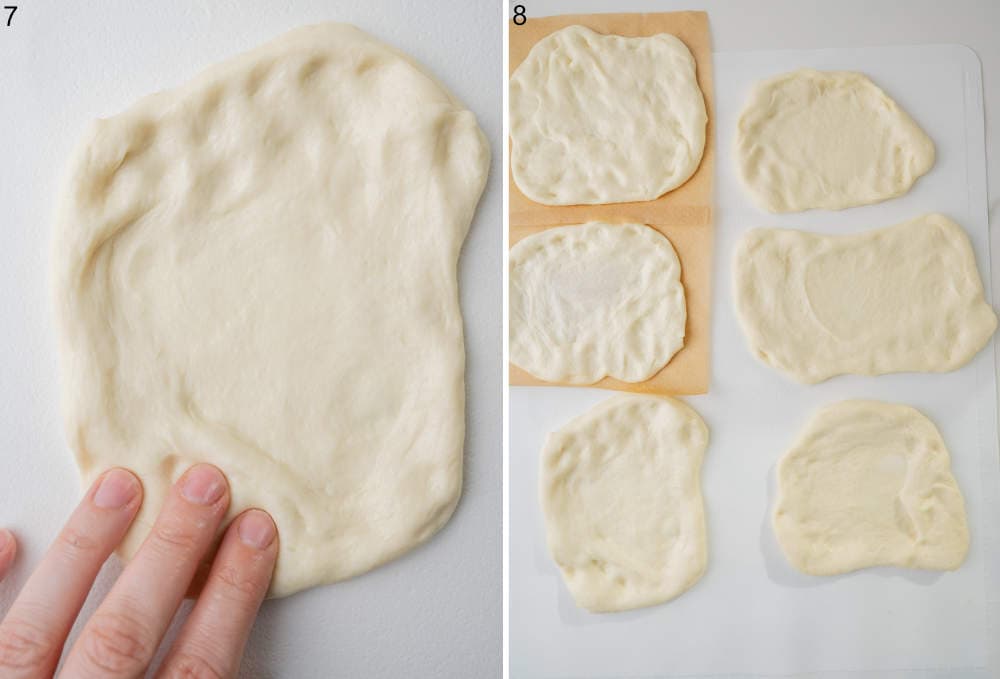
Lightly flour your hands and stretch the dough into rounds, about 1/3 inch (8mm) thick (you can shape them any way you prefer). It’s best not to roll out the dough with a rolling pin, but rather to either stretch it in your hands or press it flat with your fingers (avoid using your palms). This method creates an uneven surface for the Naan, resulting in parts that are thicker and super fluffy, alongside parts that are thinner and more crunchy – we love this contrast of textures. I also find that rolled-out Naan tends to be denser compared to Naan that is stretched or gently pressed with fingers.
TIP: Since the dough is rather loose, transferring it to the pan can sometimes be a bit difficult. If you anticipate having trouble with this step, you can stretch each portion of the dough onto a piece of parchment paper. After the resting time, place the flatbread on the pan with the parchment paper facing up, and simply remove the paper from the flatbread. This is the easiest way to move the bread onto the pan without changing its shape. Alternatively, you simply transfer the dough with floured hands. Try for yourself, which method works best for you.
Second rise: After you have shaped your flatbreads, leave them to rest for about 10 minutes.
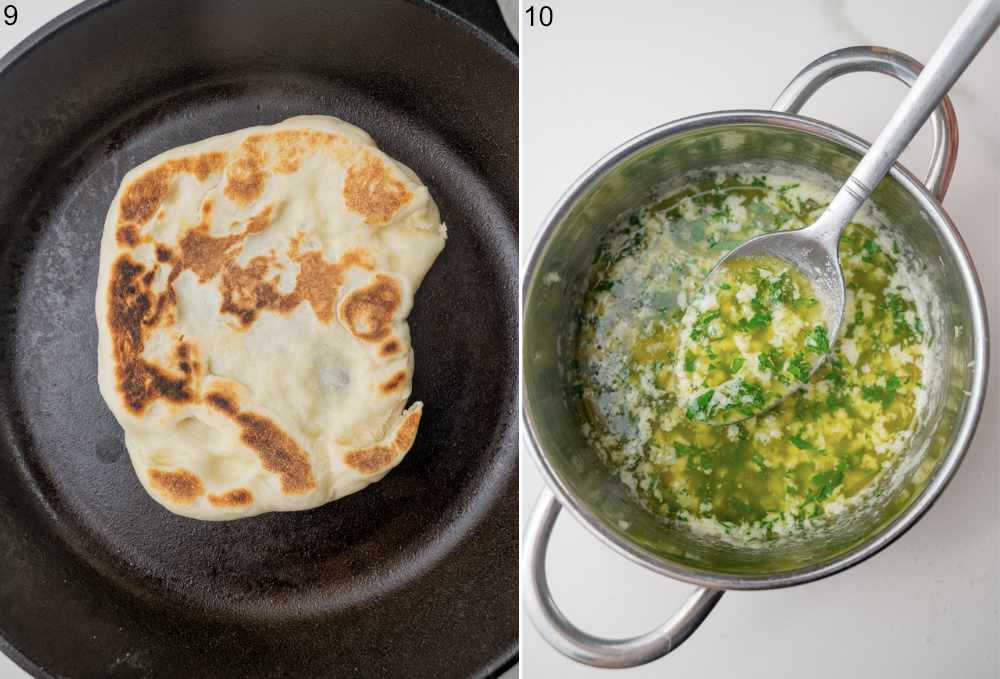
Meanwhile, make garlic butter: melt the butter in a small pot, add garlic (pressed through a garlic press) and cook for 20 seconds (to reduce the harsh flavor of the raw garlic, but don’t cook it longer so it doesn’t go away completely). Take off the heat and add parsley and salt.
(5 tablespoons butter, 4 cloves garlic, 2 teaspoons chopped parsley, big pinch of salt)
Cook Naan: Heat a thick-bottomed pan (cast iron works great) over medium-high heat.
When hot, add the first flatbread to the pan. When the flatbread is browned, turn it over and cook on the other side until well-browned (cook it for about 1-2 minutes per side).
Transfer to a plate and brush with garlic butter.
Repeat with the remaining flatbreads.
Enjoy!
Dip your Naan in this easy and delicious chickpea curry!
Storage and make-ahead instructions
How to store Naan: wrap it tightly in plastic wrap and store it in the fridge for up to 3 days. Reheat in a pan until warm. It won’t taste like freshly-made but it’s still good!
How to freeze Naan: wrap each Naan in plastic foil and freeze for up to 3 months. Reheat in a pan.
Overnight Naan:
If you don’t want to wait an hour for the dough to rise you can make your dough ahead and let it rise in the fridge overnight, it works very well!
How to do it: Make your dough and knead it until all the ingredients are combined (it doesn’t have to be kneaded very thoroughly until a smooth ball forms, 2-3 minutes of kneading are enough). Place the dough in the fridge and let it rise until doubled in volume – at least 18 hours for up to 24 hours. Take it out of the fridge and divide it into 6 pieces. Roll out each piece of the dough into a flatbread (it won’t work just pressing it flat with your hands like described above because the dough will be cold and not elastic). Cover loosely with plastic foil and let rest for about 30-40 minutes or until puffed up and warmed. Cook as described above.
Did you make this recipe? RATE THE RECIPE or tell me in the COMMENTS how you liked it! You can also add a photo of your dish. It would make me very happy and will help other readers. Thank you!!
Garlic Naan Bread
Ingredients
for the Naan:
- 1/2 cup (120g) milk
- 1 teaspoon sugar
- 1/2 tablespoon instant yeast (6g)
- 2 cups (250g) flour spooned and leveled, not scooped
- 3/4 teaspoon fine sea salt
- 2 tablespoons (30g) butter melted and cooled
- 1/3 cup (80g) plain full-fat yogurt
garlic butter:
- 5 tablespoons butter
- 4 cloves garlic
- 2 teaspoons chopped parsley
- big pinch of salt
Would you like to save this?
Instructions
- Make the dough:
- Proof yeast (not entirely necessary if using instant yeast but it helps to be sure that yeast is working and the dough is rising faster): Heat milk to 100-105°F (38-40°C) – it should be pleasantly warm to the touch, it can't be too hot. Add sugar, and yeast, and set aside for 5-10 minutes. After this time the mixture should be foamy – a sign that yeast is working. If it's not – you need to start over.1/2 cup (120g) milk, 1 teaspoon sugar, 1/2 tablespoon instant yeast (6g)
- In a medium/large mixing bowl, stir together flour and salt.2 cups (250g) flour, 3/4 teaspoon fine sea salt
- Add the yeast-milk mixture, melted and cooled butter, and yogurt.2 tablespoons (30g) butter, 1/3 cup (80g) plain full-fat yogurt
- Stir with a wooden spoon until roughly combined.
- Knead by hand or with a mixer fitted with a dough hook attachment. The dough will be very sticky so it will be difficult to knead by hand. Add more flour if you must, but try to avoid it. If using a mixer, knead the dough for about 5 minutes or until it pulls away from the edges of the bowl.
- Coat your hands in a small amount of vegetable oil and take the dough out of the bowl on a counter or a rolling mat. Grease the bowl with a small amount of oil. Knead the dough briefly until it forms a smooth ball that is not sticky anymore.
- First rise: Put the dough back in the bowl. Cover it with plastic wrap and set aside until doubled in volume, for about 1 hour (I'm putting it in a turned-off oven with a light on).
- Shape the flatbreads: Place the dough on a counter/silicone rolling mat and divide it into 6 parts.
- Lightly flour your hands and stretch the dough into rounds, about 1/3 inch (8mm) thick (you can shape them any way you prefer). It’s best not to roll out the dough with a rolling pin, but rather to either stretch it in your hands or press it flat with your fingers (avoid using your palms). This method creates an uneven surface for the Naan, resulting in parts that are thicker and super fluffy, alongside parts that are thinner and more crunchy – we love this contrast of textures. I also find that rolled-out Naan tends to be denser compared to Naan that is stretched or gently pressed with fingers.
- Since the dough is rather loose, transferring it to the pan can sometimes be a bit difficult. If you anticipate having trouble with this step, you can stretch each portion of the dough onto a piece of parchment paper. After the resting time, place the flatbread on the pan with the parchment paper facing up, and simply remove the paper from the flatbread. This is the easiest way to move the bread onto the pan without changing its shape. Alternatively, you simply transfer the dough with floured hands. Try for yourself, which method works best for you.
- Second rise: After you have shaped your flatbreads, leave them to rest for about 10 minutes.
- Meanwhile, make garlic butter: melt the butter in a small pot, add garlic (pressed through a garlic press) and cook for 20 seconds (to reduce the harsh flavor of the raw garlic, but don't cook it longer so it doesn't go away completely). Take off the heat and add parsley and salt.5 tablespoons butter, 4 cloves garlic, 2 teaspoons chopped parsley, big pinch of salt
- Cook Naan: Heat a thick-bottomed pan (cast iron works great) over medium-high heat.
- When hot, add the first flatbread to the pan. When the flatbread is browned, turn it over and cook on the other side until well-browned (cook it for about 1-2 minutes per side).
- Transfer to a plate and brush with garlic butter.
- Repeat with the remaining flatbreads.
- Enjoy!
Notes
- You can add baking powder and baking soda to the recipe if you want your Naan bread to be even more soft and fluffier. I find it not necessary. When using just yeast, most of the Naan bread is soft and fluffy and the thinner parts in the middle are crunchy. When using both the yeast and baking powder with baking soda, I find the Naan too fluffy but still very very good. I just prefer to use just yeast.
- Calories = 1 flatbread (1/6 of the recipe). This is only an estimate!

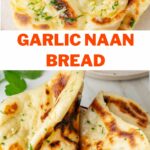
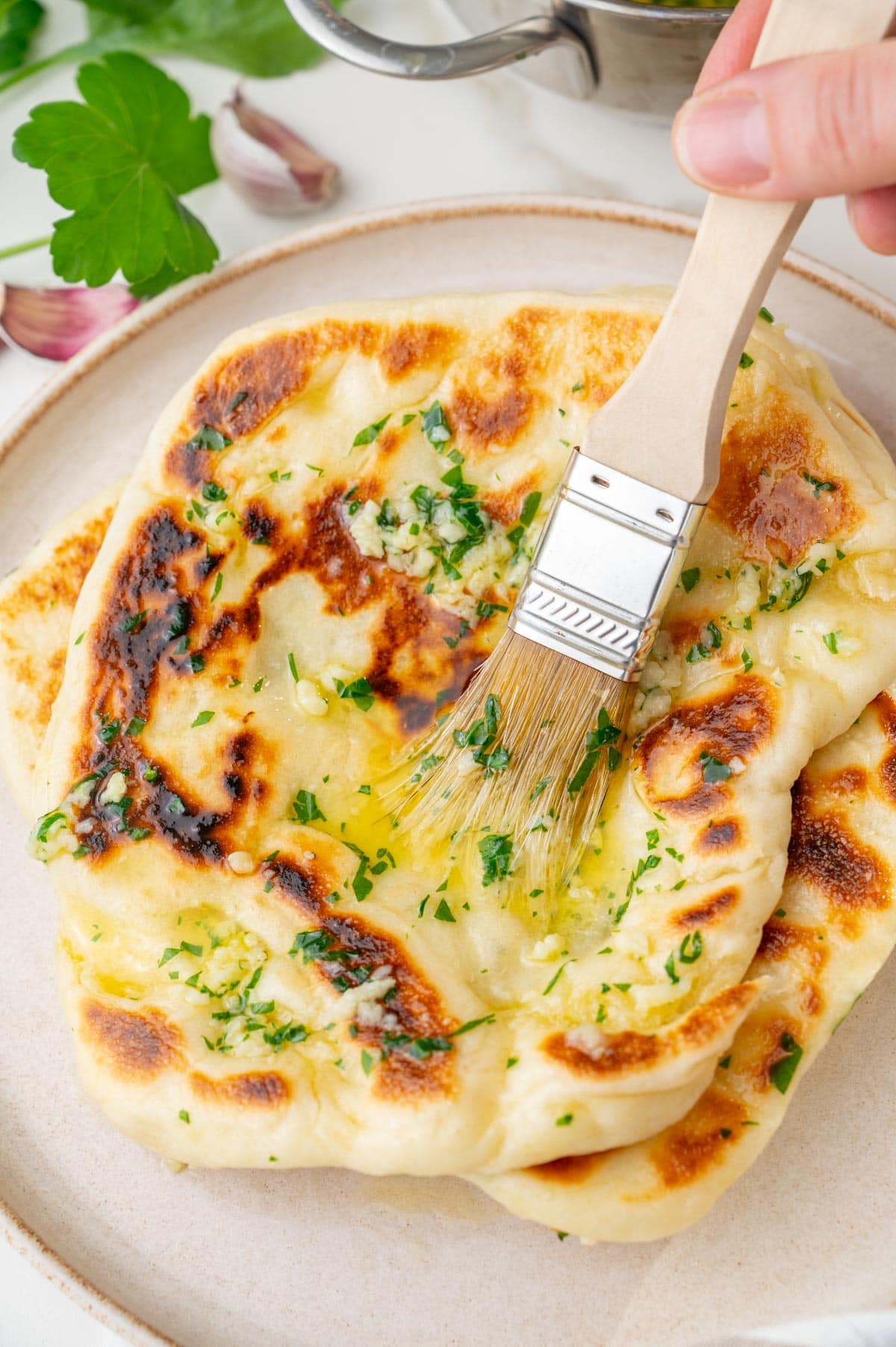
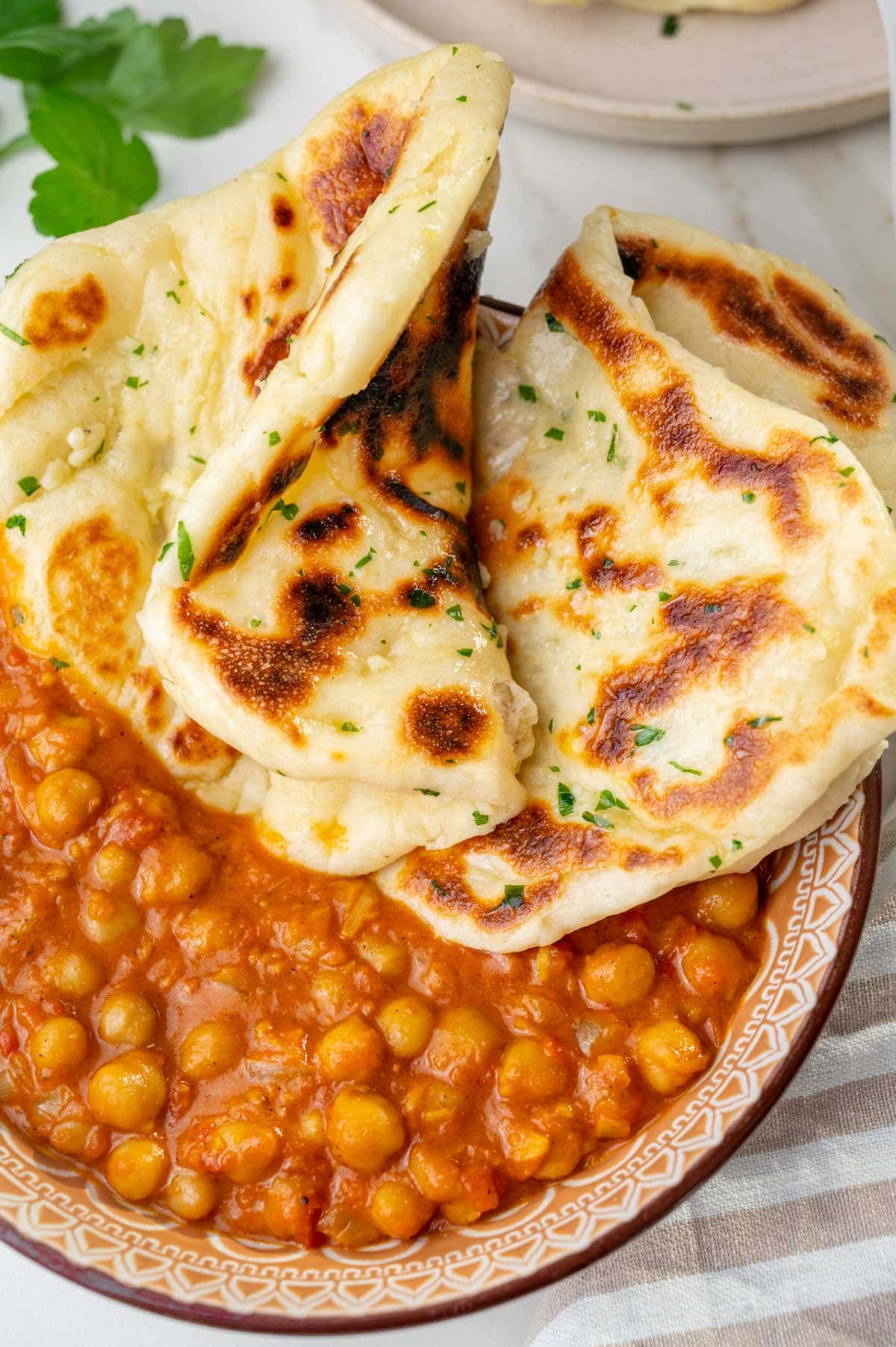
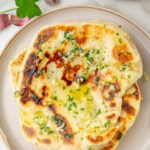
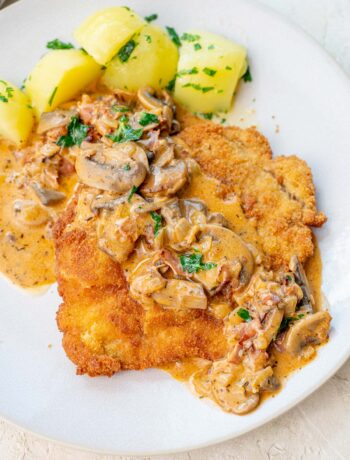
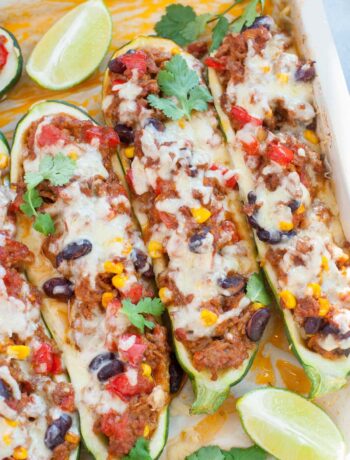
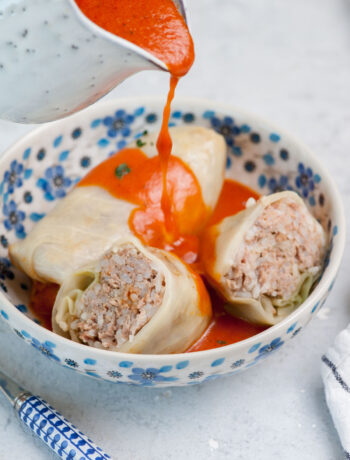
No Comments